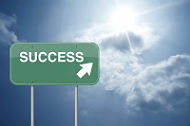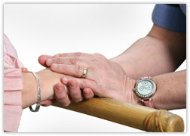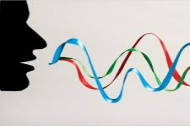
|
|
Barbara Dean Schacker - founder
Barbara discovered the Sensory Trigger Method in 1972 when she started working with her father, an untreatable global aphasic. For 9 years, Vernon Keller Dean could say only 9 words, even after 2 years of speech therapy. She invented a picture and paper based therapy that brought back his understanding of spoken language, then his ability to say and repeat words and then to copy the words in long hand in his notebooks. 18 months later, he said his first spontaneous word. After that, new words came back one by one and at the time of his death, he could say over 700 words, go to the store, the bank and the post office and ride on the bus by himself. He also became an artist with his left hand. Later, Barbara designed and published the first natural-voice software for speech therapy and home applications in 1988. She was honored in 1991 to receive the John's Hopkins University Certificate of Achievement Award for improving the quality of life for the disabled through technology. Reader's Digest featured her father's amazing speech recovery and her life story, ?Prisoner of Silence?, written by Geeta Dardic, in the June issue of 1991. Since then she has continued to research the brain, alternative therapies and approaches for speech recovery after stroke or traumatic brain injury. Over the course of about 8 years, over 50,000 people were help by her programs.
In 1999, she created the first online talking software for aphasia and was very successful, creating the Let's Talk program and then Speech Tree and Speech Bridge. These new programs were based on a Core Words lexicon of the most frequently spoken words. The words, found in the Core Words Talking Dictionary are the easiest to say words, and words used frequently in everyday conversations and words especially needed by the disabled. She authored a new guide, Pathway to Speech Recovery, that teaches the method and trains therapists and family members. This extensive guide explains how STM is done using the hand to imprint new words and pathways during normal daily activities and how to "trigger" speech in conversation and when the speaker is "stuck". It is especially useful for those who do not have access to a computer or are not able to use a computer. Based on her research in neuroplasticity, she realized the importance of combining in-the-moment techniques with specific speech practice (i.e.the programs) and found that this could breakthrough apraxia and related cognitive problems like memory loss and other speech blocks--areas outside of normal speech therapy. Her new STM technique has been able to get people to say their first words or sentences within 15 to 30 minutes. The new STM technique was developed as a result of the work with her husband, Michael, to bring back his speech and make it possible for him to say complex words and full sentences. One-on-one STM training and speech practice is available on the phone and using Skype, a free video phone service. The combination of the programs plus the new STM technique is proving to be the most effective with people of all ages and almost all stages of recovery.
In 2008, she saved her husband, Michael, from a near-fatal major aortic dissection. As a result of the high-risk operation to save his life, Michael?s left hemisphere was almost completely wiped out. The neurologists showed her the CAT scan and said "There will be no speech". When she asked about speech therapy, he repeated, "There will be no speech, it just isn't possible. The damage is too great to the left hemisphere and there is also damage to the right side." Ignoring this dire prognosis, she started the Sensory Trigger Method when he was still in a coma. Using STM, she got him to say his first word: read. It was then clear he had not only aphasia but apraxia--he said "read" for everything. She worked steadily with him everyday and the repetition faded away as new words were spoken and repeated and as spontaneous words emerged. In 18 months Michael was able to talk in words, phrases and sentences and have meaningful in-depth conversations. (See video on home page.)
Barbara says,"My approach and my programs have a sound evidence base that goes beyond my extraordinary experiences. More and more therapists realize that family members and caregivers can be trained in speech therapy and STM techniques and knowledge and skills to support the family's crucial role in the recovery of their loved ones."
In addition to Stroke Family, Barbara now heads and maintains all the web sites and projects that she built with her husband, while continuing to help him regain is life as a writer.
Michael Schacker, cofounder (1988 - 2008 Died: 2014) Michael ran the operations and marketing of Creative Learning, Inc. the publisher of the first computer programs and was in charge of sales and marketing for StrokeFamily.org. Michael Schacker is the author of "A Spring Without Bees, how colony collapse disorder has endangered our food supply." by The Lyons Press, 2008 and The Global Curriculum, an online progressive, alternative world high school curriculum?which is yet to be published. He headed The Global Regeneration Corp.(now defunct) which has now evolved into The Global Regeneration Network. In addition to being a science and political writer, he has been a musician and composer, composing a musical based on the life of William Blake. Michael previously authored and developed an online course for the Rodale Institute on "How to transition to Organic Farming" as well as Crisis Management, Code of Conduct and many other projects.
Michael was forced to retire when he suffered a massive traumatic brain injury in the spring of 2008. He continued to recover with the help of the special approach to speech recovery, the Sensory Trigger Method developed by his wife, Barbara. The neurological team at Albany Medical Center said that because he lost almost his entire left hemisphere that speech was not going to be possible. Ignoring the prognosis, Barbara started STM with Michael while he was in a coma. Using STM, she was able to get responses to questions, while he remained unresponsive to everyone else, much to the surprise of the doctors and nurses in the ICU. AMC was delighted with this and allowed her to show the nursing staff how to do it and they soon were using it with other patients. Using the Sensory Trigger she then was able to get him to say his first word a month later while he was hospitalized in the lung and brain rehab programs at Sunnyview, an acute care center. He received speech therapy there and later at Northeast Center for Special Care for over 2 years but regained very little speech. Michael continued to progress slowly but steadily with STM and a combination of holistic approaches. LENS neurofeedback therapy at Stone Mountain Center in New Paltz by Dr. Stephen Larsen resulted in his being able to get out of his wheelchair and walk with a hemi-walker and to regain his cognitive skills and personality. Neurofeedback alone, however, did not result in speech recovery directly. In addition to Sensory Trigger work, Music and Singing Therapy, by music therapist Rick Shosinsky improved his speech recovery. In addition, Intensive Chinese method of acupuncture for stroke recovery resulted in Michael being able to walk unassisted and without a cane in just the first treatment. Last but not least, he would not have this extraordinary recovery if not for the help and support of his family and many friends.
Michael lived for six and a half years post TBI. During this time, his second book Global Awakening, New Science and the 21st Century Enlightenment released by Inner Traditions publisher in December 2012 is a book about the shift in consciousness that will make a positive future for the planet possible. He had almost finished the manuscript when he suffered his massive brain injury. Dr. Stephen Larsen helped find a publisher for this book. Barbara then finished and updated the content of the book and worked with the publisher to produce the book. Michael was able to read the new manuscript and consult with Barbara during this process. Barbara now acts as his spokesperson for Michael's written achievements.
Michael continued to regain his speech and work independently by working with his own manuscripts using the Sensory Trigger Method under the observation of his wife, Barbara. He was active in helping Democratic political campaigns and attending many other community events related to his interests until he passed away suddenly on October 30th, 2014 due to a cardiovascular event related to his damaged aorta artery.
Barbara Schacker is continues her work breaking through aphasia and apraxia using a new, more advanced Sensory Trigger technique she had developed especially for Michael. Her work continues at Strokefamily.org (focusing on stroke survivors and more oriented toward families) and SpeechRecovery.com (oriented toward
Traumatic Brain Injury as well as stroke). SpeechRecovery.com will also focus more attention on how the Sensory Trigger Method can be used by professionals in the speech and language field. She now works with speech therapists along with their families on Skype STM training Sessions. The therapists can then see first-hand how the techniques work and experience the wonderful results. Because of the long successful track record of STM and the documented evidence base, more therapists are now recognizing the value of STM as a complementary approach that they can use--when appropriate--in the context of their own work with clients.
Peer Reviewed article - neuroscience magazine 2013 features Strokefamily.org - Sensory Trigger Method works well with LENS Neurofeedback and Neuro-Gen treatments. The article, "Stroke Family" by renownd author and neurotreatment practitioner, Dr. Stephen Larsen was featured on NeuroConnections Magazine Neurofeedback enhances the effect of STM, expanding the mental and physical resources for stroke and brain injury by creating more recovered brain areas for STM to build upon.
|




